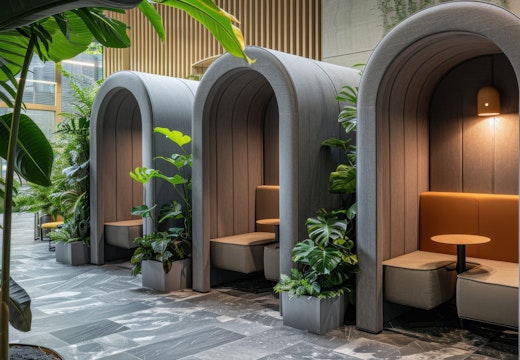Which nature scenes do most to stave off mental exhaustion?
Exposure to nature is generally regarded as an aid to restoring depleted cognitive resources. But new international research suggests that not all natural environments are equal
It is one the truisms of the workplace that when people are mentally worn out, they’re often irritable and difficult to work with. It’s also widely accepted that workplace design can help exhausted employees to refresh their minds, perform to their full potential and enjoy more pleasant interactions with colleagues.
Successive research studies have focused on how experiencing nature in the workplace can revitalise cognitive resources. Now, an international research team led by Marta Straga of the University of Trieste, Italy, has cast fresh light on the subject.
The researchers explain that ‘previous research has tended to compare the restorative potential of hospitable natural environments, such as lakes, with the restorative potential of harsh built environments, such as streets with traffic. Thus, it has overlooked the potential restorativeness of hospitable built environments such as libraries, or the potentially limited restorativeness of harsh natural environments, such as deserts.’
Harsh nature scores lower
In their study, which has been published in the Journal of Environmental Psychology the Straga-led team found that although ‘hospitable natural environments showed the greatest overall perceived restorativeness, hospitable built places were rated as more restorative than harsh natural ones.’ Harsh built environment settings, such as airport interiors, downtowns industrial areas and roads with traffic, were not felt to be very restorative.
Hospitable natural environments were defined as including such scenes as woods, rivers, lakes, seaside, lawns and mountains; harsh natural environments included deserts, savannahs, caves, volcanos, lagoons and iced landscapes; and hospitable built environments included museums, libraries, historical city centres, home interiors and urban parks.
The researchers note that perceived restorativeness seems to depend ‘on the degree to which perceived safety supports the opportunity to reflect. . . places for reflection need to be perceived as safe, able to stimulate a being-away experience, and not too cognitively engaging’.
Building on studies
Not only does the research give broad guidance on the type of natural imagery that might revitalise cognitive resources in the workplace, but its results also build on previous studies which look at mental restoration. For example, viewing artwork (photographs or paintings, still or moving) that realistically presents nature scenes is mentally restorative, returning professional performance to pre-exhaustion levels (Veitch, 2012; Gifford, 2014). The same goes for images that are only slightly abstracted from ‘real’ situations (for example, only the major branches of a tree are shown, not all the branches).
White, Smith, Humphreys, Pal, Snelling and Depledge (2010) determined that ‘as predicted, both natural and built scenes containing water were associated with . . . higher perceived restorativeness than those without water. . . Intriguingly, images of “built” environments containing water were generally rated just as positively as natural “green space”.’ The same effect was identified whether water was naturally occurring, as in a river, or not (for example, in a fountain).
‘Built environments containing water were generally rated just as positively as natural green space’
Lee, Williams, Sargent, Williams and Johnson (2015) found that ‘micro-breaks spent viewing a city scene with a flowering meadow green roof . . . boost sustained attention. Sustained attention is crucial in daily life and underlies successful cognitive functioning’. Participants who viewed the green roof for 40 seconds did a better job on cognitive tasks than participants who viewed a concrete roof. Looking at fish tanks, whether or not they have fish in them, is also mentally refreshing (Cracknell, 2012).
Twedt (2014) studied how participants rated the perceived restorative potential of environments that ranged on a continuum from completely natural to completely built. The data suggested that nature environments are perceived to be the most restorative, but this is partially due to higher visual appeal.
Meanwhile, Mattila and colleagues (2020) determined that experiences with both visual and acoustic components in virtual reality can be mentally restorative: ‘VR technology could have an effective restorative function during a school or work day when there is no access to highly restorative natural environments’.
Read more of the latest research insights from Sally Augustin in Research Round-up, her regular column in the Innovation Zone here.
Research sources
Robert Gifford. 2014. Environmental Psychology, Fifth Edition, Optimal Books: Colville, WA.
Andreas Haga, Niklas Halin, Mattias Holmgren and Patrik Sorqvist. 2016. ‘Psychological Restoration Can Depend on Stimulus-Source Attribution: A Challenge for the Evolutionary Account?’ Frontiers in Psychology, vol. 7, article 1831.
Kate Lee, Kathryn Williams, Leisa Sargent, Nicholas Williams, and Katherine Johnson. 2015. ‘40-Second Green Roof Views Sustain Attention: The Role of Micro-Breaks in Attention Restoration.’ Journal of Environmental Psychology, vol. 42, pp.182-189.
Osmo Mattila, Arto Korhonen, Essi Poyry, Kaisa Hauru, Jani Holopainen, and Petri Parvinen. 2020. ‘Restoration in a Virtual Reality Forest Environment.’ Computers in Human Behavior, vol. 107, 106295.
Marta Straga, Clara Miani, Timo Mantyla, Wandi de Bruin, Mattia Mottica, and Fabio Deo Missier. 2023. ‘Into the Wild or Into the Library? Perceived Restorativeness of Natural and Built Environments.’ Journal of Environmental Psychology, vol. 91, 102131.
Elyssa Twedt. 2014. ‘Restorative Environments: The Role of Visual and Observer Characteristics’. Dissertation Abstracts International: Section B: The Sciences and Engineering, vol. 74 (11-B(E)).
Jennifer Veitch. 2012. ‘Work Environments.’ In Susan Clayton (ed.), The Oxford Handbook of Environmental and Conservation Psychology. Oxford University Press: New York, pp. 248-275.
Mathew White, Amanda Smith, Kelly Humphreys, Sabine Pal, Deborah Snelling, and Michael Depledge. 2010. ‘Blue Space: The Importance of Water for Preference, Affect, and Restorative Ratings of Natural and Built Scenes.’ Journal of Environmental Psychology, vol. 30, no. 4, pp. 482-493.








